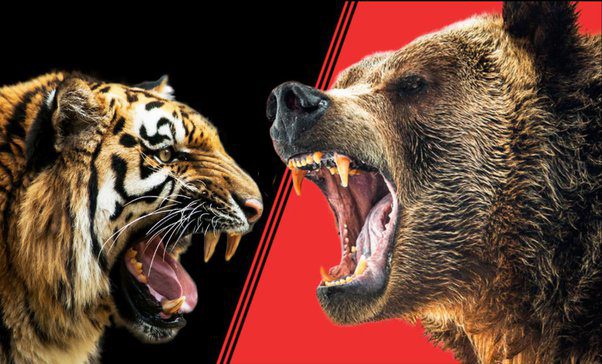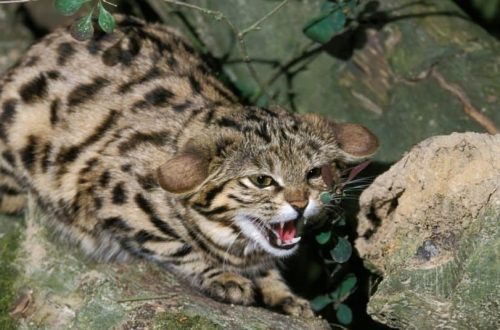
Who is stronger: a lion or a bear or a tiger? Features of animal tactics
Although these predators do not always live in the same territory, it is still interesting what will happen if they meet? Who will win the fight? This article will focus on which of these predators – a bear, a tiger or a lion – have more power. If this question has always interested you, then below you will find the long-awaited answer.
Contents
Polar bear and Amur tiger
First, let’s analyze a couple of the strongest – a polar bear against the Amur tiger. Polar Bear Benefits visible to the naked eye. He is strong and very large, in addition to this, he has a strong impact of about 1,5 tons, which indicates a good muscle mass. He also has speed with a sharp blow. The average weight reaches 450 kg, it is twice as heavy as a tiger. The height at the withers of a white strong man is 130-150 cm, which is slightly more than that of the Amur tiger, which has an average height of 120 cm.
- Scientists are sure that the force of impact, which the clubfoot possesses, is capable of breaking the back of the tiger, which can cause him to instantly lose his life.
Everything is clear with large clubfoot individuals, but what about their less powerful counterparts? Probably not everything is so obvious here.
Brown bear vs. Ussuri tiger
According to the statistics kept by zoologists, and44 collisions are known a tiger with a brown bear: half of them ended in the defeat of the bear, 27,3% – the death of the tiger, and 22,7% – the predators dispersed. These data indicate that the tiger is stronger than the bear.
But with a careful study of the relationship between these animals, it becomes clear to scientists that the brown beast behaves more aggressively, especially during the period of lack of food. And the striped one tries to attack medium-sized individuals. A tigress fights with any clubfoot and sacrifices herself to protect her cubs.
There is a described a case of a fight between a large tiger and a bear.
The tiger attacked a ten-year-old bear weighing about 180 kg. At the place of the fight, a platform of 8 meters was formed. After the victory, the tiger stepped aside for 15 meters to catch his breath. A wound was bleeding on his body.
As can be seen, a large male weighing about 205 kg had a difficult duel with a she-bear, whose weight was no more than 200 kg. Even a victim smaller than he was able to turn an instant kill into a long romp that had become so tiring for him. Thus, if there was a large male weighing about 380 kg in place of the she-bear, he is unlikely to become a victim.
The larger the clubfoot, the lower chances for a tiger to win. This is not an elephant, there are no such places on his body, clinging to which the tiger himself could remain out of reach. Therefore, with a bear, the tactics of devouring alive are doomed to failure. He is not a buffalo, to let himself be grabbed by the throat so easily. Even if they manage to do this, the bear will still have free paws, just in time to break the back of the tiger. The tiger is not too large an animal not to be able to break its spine.
The paws of the clubfoot seem to be created to break the ridges. He is able to break the spine of an elk, a wild boar, thus a strong blow to the back from above, as well as a hall in a duel – and there is no tiger. He is not able to stand against him on his feet, they do not have sufficient strength, standing on his hind legs, the bear is still more stable.
Tactics and technique
Clumsy uses the same tactics. Although he is smarter than a tiger, he does not have the technique. Our ancestors used this. The bear simply rushes and crushes the body of the victim under him (just like a sumo wrestler). And most likely, against such a primitive tactic, built only on mass and strength, the opponent will not resist. Because a long tactical duel with a bear is a waste of time. The clubfoot is more resistant to pain shock, blood loss, its paws are more powerful, and the bone is stronger.
The only chance for success is quick killer tactics. The enemy’s weak spot is the throat. If the striped one could grab it around the entire circumference, capturing the arteries and compressing it, then the bearish resistance would soon come to naught, because the carotid artery is clamped. But can such a thing be done? It is required to clasp this powerful neck, and in large representatives it has excellent protection in the form of muscles that protect the trachea and arteries located very deep. The big man, on the other hand, is actively resisting, and at the same time he himself can grab by the throat. Thus, whatever one may say, such fights can often end not in favor of the tiger.
- A bite in the throat, as the only chance to resist the enemy, is illusory for a tiger.
Himalayan bear vs tiger
Renowned naturalist Jim Corbett claims that he has repeatedly seen Himalayan bears confidently and fearlessly chase away tigers at the most inopportune moment when they were having a good lunch. Himalayan bear has a brave and aggressive disposition: sometimes he attacks tigers, which are bypassed by larger brown bears. However, unpredictable endings also happen, when two formidable predators come into battle.
Well nevertheless who is stronger, clubfoot or striped? With equal sizes, these animals are almost equal in strength. But there are nuances:
- The one who is older, braver and angrier wins.
- Young males of one and the other camp fight less skillfully than seasoned ones, who are full of strength and courage.
- An important point in favor of one of them is who attacked first, as well as who is full or hungry. A well-fed predator is not as angry and impudent as a hungry one.
- It is also important on whose territory the opponents met: whoever has a closer home fights more fiercely. Rage is often stronger than force.
One can imagine equal fight of one weight category, which ends with the victory of a feline representative, but his chances of meeting the largest representatives of this species are negligible. Be it Kodiak, Kamchatka giant, grizzly or white. Even brown individuals can reach a weight of more than 700 kg. Their mass, endurance, blunt strength beats all the trump cards of the opponent. A clubfoot is not a buffalo that can be killed by cutting the tendons. Is it possible to kill a giant in the first 5 minutes, if the buffalo is not always possible?
Who is stronger, the lion or the bear?
A duel between a tiger and a bear is stronger than a lion against a bear. After all, it makes no sense to fight, building tactics against a bear. Here need the ability to kill quickly. Perhaps a lion would have distinguished itself with a better result, because in ancient Rome the confrontation between a lion and a European brown bear was considered the most spectacular, and not a tiger with him. Both animals did not get tired immediately. Being a tactician and a genius of strategy, as well as having experience in battles with small individuals, maybe a lion would find an approach to Kodiak? It is unlikely that this will happen for the reasons described above.





